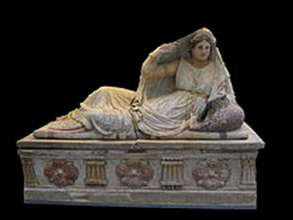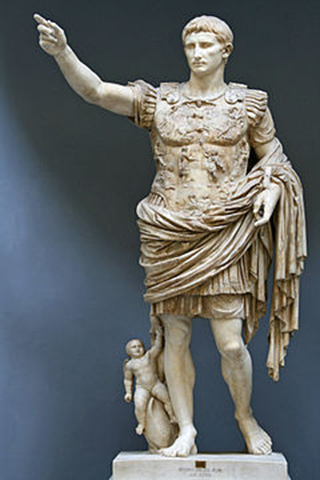Etruscan and Roman Art
People from Central Europe came down to Italy and settled on the banks of Tiber River about 2000 BC.Etruscans who entered Italy in 14th and 13th century BC won over the primitive inhabitants. The second wave of Etruscans came during 11th and 10th century BC. They came from Lydia in Asia Minor as a result of prolonged period of economic depression. They were agriculturalists, traders, warriors and sea pirates. They led a luxurious life because they were comparatively richer than the primitive people. Excavations in Etruria have revealed the art resembling that of Mesopotamia regarding Gods and Assyria regarding hunting scene. Later Romans became stronger and stronger because Etruscans had little idea of the benefits of cooperation and they fought with each other. The Romans won over them very easily. In 510 BC Etruscans were expelled from Rome and in the beginning of 4th century BC Romans took the strong hold of Veii of Etruscans; other Etruscans’ cities fell to Romans and by the beginning of 2nd century BC whole of Italy became Roman.
Romans extended their empire during 2nd and 1st century BC and became the masters of the whole Mediterranean world extending from Mesopotamia in the east to Spain, France and Britain in the west. Wherever they went they took Roman Culture with them and the people who came in contact copied them in every part of life. Thus the fashion, architecture, art and the same way of life prevailed throughout the Empire as belonged to Rome. Every free man was the citizen of Rome and had the right to vote at the meetings in Rome if he could reach there.
In 146 BC they conquered Greece thereafter Greek art prevailed in Rome. Greek influence was responsible for the introduction of building theatres into Italy. The great one at Pompeii was built in 2nd century BC with bricks and the first stone built theatre in Rome in the year 55 BC. Thus Roman art developed with the assimilation of two distinct schools that is Etruscan and the Greek. Etruscans depicted their males rugged and fearful and the females of lighter complexion and milder features. Their art was connected with the dead like Egyptians.

Painted terracotta sarcophagus of Seainti Hanunia Tlesnasa, about 150-130 BCE
Excavations from tombs have revealed many things of Etruscan Art.The magnificent tombs had wall paintings of the scenes of daily life. In low reliefs on the pillars and walls they painted household goods belonging to the dead as if the actual objects were in fact hanging there such as bags, baskets, arms of the dead etc. They also painted scenes of feasts, hunting and dancing.
They buried as well as cremated their dead but built monuments for both. Sarcophagus contained the dead bodies or the caskets with the ashes of the dead. Sarcophagi really means a flesh eating stone because Greek used to think that the certain sorts of stone would consume the dead body quickly and they were therefore highly desirable for coffins. Romans did not take marriage vows very seriously but Etruscans couple was never to be separated. Therefore a few sarcophagi have the effigies (images) of the husbands and the wife side by side on the lids of the coffins. Vex masks were also take n of the dead and kept as family portraits in the houses and this gave rise to portrait busts.
Roman wall paintings are usually in fresco technique. Though at first the painters painted directly upon the stone. Thick plaster made of Pozzuolava the volcanic sand near Naples is still used to form hydraulic cement mixed with lime. Once this concrete sets; it became very hard. Tufa a dark and porous volcanic stone was also sometime powdered to prepare the plaster. When Romans came into contact with France and found marble they mixed marble dust also into the plaster. This carefully prepared plaster was laid layer after layer beaten with smooth trowel till it became compact. It was kept wet for a very long time so that the artist might work at leisure. Colors were bright, red and black were usually used to give figures an idea of relief with rich creamy white in border.
Paintings on wooden panels that were put on the walls have been found in Egypt in great numbers. Most of them belonged to 1st and 2nd century AD.These portraits have life like expression. In Rome the oldest paintings have been found in tombs that were executed on a white ground. These portraits were concerted either with the dead or with mythology or history. Some of the famous painters that appear in Roman literature were Fabulous, Cornelius Pinus, Appius Prisens who belong to 1st and 2nd century AD. Romans believed in bigness, they were confident that the size impressed the masses therefore they did everything on massive scale. Roman painting, architecture and sculpture were used for state publicity and for its rulers. Roman lettering was also designed and well proportioned. Emperor Titus finally completed Roman Colosseum in 80AD that alone could seat 87000 people.

The statue of Augustus found in the Villa Livia.
The theatre of Pompeii, the buildings of Herculaneum, the villa di Misteri or the villa of mysteries and the villa of Livia were very huge buildings. In Fiorum that was primarily a market place Basilica was built which was Roman invention.
In the beginning it was of oblong shape but later when Roman emperors made Christianity as state religion it was converted into a square, the judges seat became the alter and its walls were decorated with the portraits of Christ and other saints and disciples. In all such buildings there were wall paintings or paintings on wood put against the walls. In a wall decoration in a Pompeii house, architectural details such as columns and arches were painted as to give an illusion of depth and distance landscape. There were windows opened and shut with or without curtains and mysterious archways to give a view of open country and landscape.
The whole history of Roman Painting can easily be divided into 4 styles or periods.
Incrustation Style when the walls were coated with the plaster containing Pozzuolava or the volcanic sand mixed with marble dust just to give imitation in plaster for marble paneling. Tufa sand was mixed to reproduced colored walls.
Architectural or illusive Style as appears in the houses of Pompeii in Villa dei Misteri and Villa Livia.This belong to 1st century BC.
Egyptian Style according to this style walls were divided into square panels that were usually painted and the subject was mostly decorative containing floral designs including birds, wreaths, scrolls and small creatures. The colors were violet, blue, red, yellow and black. This style is also called ornate style. Emperor Nero built this golden house in the heart of Rome during this period and made it a treasure palace of Greek Art.
Intricate Style where decoration became fanciful and complex and the artist only played with colors unmindful of their effects. So compared with the fine soothing color scheme of the third style the fourth style became very bright and intricate.
During the middle of the 4th century A D the Roman Empire was divided into two parts. Constantinople became the capital of eastern half and fifty years later the capital of the Western Roman Empire was shifted from Rome to Ravenna. Three generations later as Barbarian chieftain replaced the Roman Emperor and Roman Empire came to an end. There after when Roman Emperors declared Christianity as the state religion, Rome became the principle seat of Christianity.